Lares, Puerto Rico
Lares (Spanish pronunciation: [ˈlaɾes]) is a city and a mountain municipality of the U.S. territory of Puerto Rico's central-western area located north of Maricao and Yauco; south of Camuy, east of San Sebastián and Las Marias; and west of Hatillo, Utuado and Adjuntas. Lares is spread over 10 wards and Lares Pueblo (Downtown Lares). It is part of the Aguadilla-Isabela-San Sebastián Metropolitan Statistical Area.
Lares Municipio Autónomo de Lares | |
|---|---|
City and Municipality | |
 The City Hall in Lares, 2019 | |
 Flag | |
| Nicknames: Ciudad del Grito (The Town of The Grito), Altar de la Patria (Altar of the Fatherland), La Capital de la Montaña (Capital of the Mountains)[1] | |
| Anthem: "En las verdes montañas de Lares" (In the green mountains of Lares) | |
 Location of Lares in Puerto Rico | |
| Coordinates: 18°17′42″N 66°52′43″W | |
| Commonwealth | |
| Founded | April 26, 1827 |
| Government | |
| • Mayor | José I. Rodríguez Ruiz |
| • Senatorial dist. | 5 - Ponce |
| Area | |
| • Total | 61.64 sq mi (159.6 km2) |
| • Land | 61.45 sq mi (159.2 km2) |
| • Water | .09 sq mi (0.2 km2) |
| Population (2010) | |
| • Total | 30,753 |
| • Density | 500/sq mi (190/km2) |
| Demonym(s) | Lareños |
| Time zone | UTC−4 (AST) |
| Zip code | 00669, 00631 |
| Major routes | |
A city adorned with Spanish-era style churches and small downtown area stores, Lares is a breezy area that is about 1.5 hours from San Juan by car.
A significant event that occurred in Lares, the 1868 uprising brought on by pro-independence rebels who wanted Puerto Rico to gain its freedom from Spain. The movement, known thereafter as El Grito de Lares (literally, The Cry of Lares, or Lares Revolt), was soon extinguished.[2]
The flag of Lares (the first Puerto Rican flag) is now considered by many Puerto Ricans to be the symbol of their independence movement. Initially developed to represent the island's struggle to gain its emancipation from Spain, the flag is now used by those struggling to liberate the island from the United States. The flag was displayed during the week of September 17 to 23 of 2018, at the Museum of History, Anthropology and Art located within the University of Puerto Rico, Rio Piedras Campus, to commemorate the 150th anniversary of El Grito de Lares.[3]
History
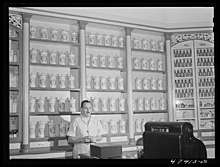
Lares was founded on April 26, 1827 by Francisco de Sotomayor and Pedro Vélez Borrero. The city was named after one of its settlers, Amador de Lariz, a Spanish nobleman.[4][5]
The United States acquired Puerto Rico from Spain in the aftermath of the Spanish-American War under the terms of the Treaty of Paris of 1898. In 1899, the US conducted its first census of Puerto Rico, finding that the population of Lares was 20,883.[6]
December 2019 and January 2020 Puerto Rico earthquakes caused 28 families in Lares to lose their homes.[7]
Hurricane Maria
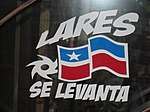
Hurricane Maria on September 20, 2017 triggered numerous landslides in Lares. In many areas of Lares there were more than 25 landslides per square mile due to the significant amount of rainfall.[8][9] Puerto Rico se levanta (Puerto Rico will stand up) became the slogan used across the island to communicate the island would rise again.[10]
When the hurricane hit, many areas in the Municipal Cemetery of Lares were damaged by landslides. Total affected were about 5,000 burial plots, with the burial places shifting and some plots opened. In response, the municipality closed the cemetery to the public.[11][12] In early 2019, El Nuevo Día newspaper in Puerto Rico began listing the names of the cadavers that would be exhumed and moved to other cemeteries, a long and delicate process. On March 4, an update was given by Lares officials on how the issue was being handled.[13] On May 10, 2019, it was announced that a decision had been made to build a temporary wooden structure separating the affected area so that family members could visit the plots that were unaffected by the hurricane-triggered landslides.[14]
Geography
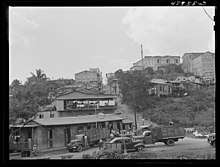
Lares is a mountainous municipality located in the central western part of the island of Puerto Rico. According to the 2010 U.S. Census Bureau, the municipality has a total area of 61.64 square miles (159.6 km2), of which 61.45 square miles (159.2 km2) is land and .09 square miles (0.23 km2) is water.[15]
Caves
There are 10 caves in Lares. Cueva Machos and Cueva Pajita are located in Callejones barrio.[16]
Barrios

Like all municipalities of Puerto Rico, Lares is divided into barrios. The municipal buildings, central square and large Catholic church are located near the center of the municipality, in a barrio referred to as "el pueblo".[17][18][19][20]
Sectors
Barrios (which are like minor civil divisions)[21] in turn are further subdivided into smaller local populated place areas/units called sectores (which means sectors in English). The types of sectores may vary, from normally sector to urbanización to reparto to barriada to residencial, among others.[22]
Special Communities
Of the 742 places on the list of Comunidades Especiales de Puerto Rico (Special Communities of Puerto Rico), the following barrios, communities, sectors, or neighborhoods were in Lares: Castañer, Cerro Avispa, Comunidad Anón, Comunidad Arizona, Comunidad El Bajadero, Comunidad Peligro, Comunidad San Felipe, and Seburuquillo.[23][24]
Tourism
Landmarks and places of interest
- El Ayuntamiento de Castañer[25]
- Hacienda Collazo
- Parque El Jíbaro
- Hacienda El Porvenir
- Heladería de Lares (ice cream parlor)
- Hacienda Lealtad[26][27]
- Mirador Mariana Bracetti
Culture
Festivals and events

- Feast of the Three Kings - January
- Romantic Party - February
- Almojabana Festival - March
- Founding of Lares - April
- Handcrafted market - May
- Banana (Guineo) Festival - June
- Cultural World Contest - August
- Grito de Lares - September
- Bonsai Gathering - October
- Feast of the Patron Saint - December
Sports
Lares has a professional volleyball team called Patriotas de Lares (Lares Patriots) that have international players including: Brock Ullrich, Gregory Berrios, Ramon "Monchito" Hernandez, and Ariel Rodriguez. The Patriotas won 3 championships, in 1981, 1983 and 2002. In 1981 and 1983 they beat Corozal in the finals and in 2002 they beat Naranjito. Some of the Native players were: David Vera 1979, Rigoberto Guiyoti 1979, Modesto 1980, Luis Vera 1980, Carlos Vera 1980,
Economy

Lares' economy is primarily agricultural. Harvested products include bananas, coffee, oranges, and tomatoes.
Tourism also plays a significant role in the municipality's economy. The Heladeria de Lares (Lares Ice Cream Shop) is well known around Puerto Rico for its unorthodox selection of ice cream including; rice and beans ice cream.[28]
There was a large population exodus, out of Lares, after September 20, 2017 when Hurricane Maria struck the island.[29]
In 2016, Rural Opportunities Puerto Rico Inc. (ROPRI) in conjunction with the United States Department of Agriculture (USDA) completed the building of 24 (one-bedroom, two-bedroom and three-bedroom) units[30] in Lares, specifically for farmers (in Spanish: agricultores), and their families, to live and work. It is called Alturas de Castañer (Castañer Heights) and there the families work to grow coffee, bananas and other crops which are sold to markets, and restaurants nearby.[31]
Demographics
| Historical population | |||
|---|---|---|---|
| Census | Pop. | %± | |
| 1900 | 20,883 | — | |
| 1910 | 22,650 | 8.5% | |
| 1920 | 25,197 | 11.2% | |
| 1930 | 27,351 | 8.5% | |
| 1940 | 29,914 | 9.4% | |
| 1950 | 29,951 | 0.1% | |
| 1960 | 26,922 | −10.1% | |
| 1970 | 25,263 | −6.2% | |
| 1980 | 26,743 | 5.9% | |
| 1990 | 29,015 | 8.5% | |
| 2000 | 34,415 | 18.6% | |
| 2010 | 30,753 | −10.6% | |
| U.S. Decennial Census[32] 1899 (shown as 1900)[33] 1910-1930[34] 1930-1950[35] 1960-2000[36] 2010[19] | |||
Like most of the people of Puerto Rico, Lares population originated with the Taino Indians and then many immigrants from Spain settled the central highland, most prominently the Andalusian, Canarian and Extremaduran Spanish migration who formed the bulk of the Jibaro or white peasant stock of the island.[37] The Andalusian, Canarian and Extremaduran Spaniards also influenced much of the Puerto Rican culture which explains the main Spanish dialect, and the Spanish architecture that surrounds the city. Europe had a lot of influence on their culture, you can see evidence of European art throughout the island as well. This area of the Island has an array of cultures. Basque, French, Corsican and Italian is highly predominant due to the introduction of coffee in this region of the Island. Unlike coastal towns, in the mountain regions of Puerto Rico the people are predominantly white.
Government
The mayor of Lares for fifteen years was Roberto Pagán Centeno and he resigned in late 2019.[38] José Rodríguez Ruiz began serving his term as mayor of Lares on January 20, 2020.[39][40] Rodríguez Ruiz belongs to the Hospitaller Order of Saint Lazarus.[41]
The city belongs to the Puerto Rico Senatorial district V, which is represented by two Senators. In 2012, Ramón Ruiz and Martín Vargas Morales, from the Popular Democratic Party, were elected as District Senators.[42]
Education
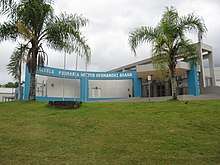
The Héctor Hernández Arana Primary school is located in Lares.[43]
Symbols
Flag
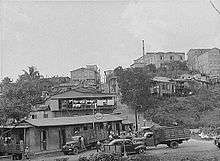
The origins of the municipality's flag can be traced back to the days of the failed 1868 revolt against Spanish rule known as the Grito de Lares. The flag is derived from the Dominican Republic flag of 1844-49 (reflecting the rebel leaders' dream to eventually join with the Dominican Republic and Cuba into one nation) and was knitted by Mariana Bracetti, a revolutionary leader, at the behest of Dr. Ramón Emeterio Betances, the revolt's leader, who designed it. This flag is formed by a white Latin cross in the center. The width of the arms and base are equal to a third part of the latitude of the emblem. It has two quadrilaterals located above and two below the arms of the cross. The superior (top) ones are blue and the inferior (bottom) ones red. A five-point white star is located in the center of the left superior (top) quadrilateral.
Coat of arms
A white cross is centered on and extends across the shield from side to side and top to bottom; it has blue top quadrants and red bottom quadrants; it has a five pointed white star in the upper left quadrant. A chain surrounds the shield. The coat of arms as described has positioned around it on a scroll and a ribbon in a semicircle the words: "Lares Ciudad del Grito." This constitutes the stamp of Lares and identifies unmistakably the municipality of Lares.
Transportation
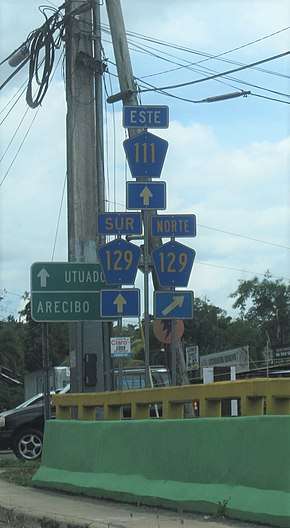
Puerto Rico State Route 111 runs through the town.
Lares has 15 bridges.[44]
Notable Lareños
- Singer, composer and Virtuoso Guitarist Jose Feliciano who wrote and sang the Feliz Navidad Song, was born in Lares in September 8, 1945
- Lolita Lebrón was a Puerto Rican nationalist who was convicted of attempted murder and other crimes in 1954 and freed from prison in 1979 after being granted clemency by President Jimmy Carter.
- Denise Quiñones - Miss Universe 2000[45]
- Luis Hernández Aquino[46]
- Odilio González (born March 5, 1937), known by his stage name El Jibarito de Lares, is a Puerto Rican singer, guitarist and music composer who has been singing and composing for more than 65 years.
See also
- List of Puerto Ricans
- History of Puerto Rico
- Did you know-Puerto Rico?
References
- "Lares Municipality - Municipalities | EnciclopediaPR".
- "The Cry of Lares". Progreso Weekly Inc. 22 September 2013.
- "Exhiben en UPR bandera de Lares con 150 años". Primera Hora. September 16, 2018. Archived from the original on July 25, 2019. Retrieved July 25, 2019.
- "History and foundation of Lares". Rootsweb.ancestry.com. Archived from the original on 2008-11-10. Retrieved 2008-11-09.
- "Lares: Ciudad de cielos abiertos". nuevaisla.com (in Spanish). SG Communications. Archived from the original on 2019-02-09. Retrieved 8 February 2019.
- Joseph Prentiss Sanger; Henry Gannett; Walter Francis Willcox (1900). Informe sobre el censo de Puerto Rico, 1899, United States. War Dept. Porto Rico Census Office (in Spanish). Imprenta del Gobierno. p. 160. Retrieved 2019-02-14.
- "Refugiadas 28 familias en Lares tras temblor 5.9 del sábado". Primera Hora (in Spanish). January 12, 2020.
- "Preliminary Locations of Landslide Impacts from Hurricane Maria, Puerto Rico". USGS Landslide Hazards Program. USGS. Archived from the original on 2019-03-03. Retrieved 2019-03-03.
- "Preliminary Locations of Landslide Impacts from Hurricane Maria, Puerto Rico" (PDF). USGS Landslide Hazards Program. USGS. Archived (PDF) from the original on 2019-03-03. Retrieved 2019-03-03.
- Newkirk II, Vann R. (20 September 2018). "The Situation in Puerto Rico Is Untenable". The Atlantic. Archived from the original on 3 June 2019. Retrieved 3 June 2019.
- "Las tumbas quedan expuestas en el camposanto de Lares". El Nuevo Día (in Spanish). September 26, 2017. Archived from the original on 2017-09-27. Retrieved 2019-03-03.
- Florida, Adrian (December 6, 2018). "'My Father Is In There': Anguish Builds In Puerto Rico Mountains Over Decimated Tombs". NPR. Archived from the original on March 27, 2019. Retrieved March 3, 2019.
- "Informe sobre el Cementerio Municipal Post-Maria". FaceBook (in Spanish).
- "Regalo de madres para familiares de difuntos en Lares". Primera Hora. 10 May 2019. Archived from the original on 13 May 2019. Retrieved 13 May 2019.
- "Lares Municipality". enciclopediapr.org. Fundación Puertorriqueña de las Humanidades (FPH). Archived from the original on 2019-06-03. Retrieved 2019-03-20.
- "Lares: Ciudad de cielos abiertos". Nueva Isla (in Spanish). SG Communications. Archived from the original on 2019-02-09. Retrieved 2019-02-08.
- Picó, Rafael; Buitrago de Santiago, Zayda; Berrios, Hector H. Nueva geografía de Puerto Rico: física, económica, y social, por Rafael Picó. Con la colaboración de Zayda Buitrago de Santiago y Héctor H. Berrios. San Juan Editorial Universitaria, Universidad de Puerto Rico,1969. Archived from the original on 2018-12-26. Retrieved 2019-01-03.
- Gwillim Law (20 May 2015). Administrative Subdivisions of Countries: A Comprehensive World Reference, 1900 through 1998. McFarland. p. 300. ISBN 978-1-4766-0447-3. Retrieved 25 December 2018.
- Puerto Rico:2010:population and housing unit counts.pdf (PDF). U.S. Dept. of Commerce, Economics and Statistics Administration, U.S. Census Bureau. 2010. Archived (PDF) from the original on 2017-02-20. Retrieved 2019-01-03.
- "Map of Lares at the Wayback Machine" (PDF). Archived from the original (PDF) on 2018-03-24. Retrieved 2018-12-29.
- "US Census Barrio-Pueblo definition". factfinder.com. US Census. Archived from the original on 13 May 2017. Retrieved 5 January 2019.
- "PRECINTO ELECTORAL LARES 053" (PDF). Comisión Estatal de Elecciones (in Spanish). PR Government. 14 June 2019. Retrieved 19 June 2019.
- Rivera Quintero, Marcia (2014), El vuelo de la esperanza:Proyecto de las Comunidades Especiales Puerto Rico, 1997-2004 (1st ed.), San Juan, Puerto Rico Fundación Sila M. Calderón, p. 273, ISBN 978-0-9820806-1-0
- "Comunidades Especiales de Puerto Rico" (in Spanish). 8 August 2011. Archived from the original on 24 June 2019. Retrieved 24 June 2019.
- Brugueras, Melba (22 August 2015). "Conoce cómo se vive en Castañer". Primera Hora. Archived from the original on 2019-02-09. Retrieved 8 February 2019.
- "Un pedacito de Hacienda Lealtad en el RUM". Primera Hora. 21 March 2019. Archived from the original on 8 May 2019. Retrieved 8 May 2019.
- "Compañía de Turismo brinda certificación agroturística a Hacienda Lealtad". 18 October 2016. Archived from the original on 8 May 2019. Retrieved 8 May 2019.
- "Histórica Heladería de Lares reabrirá sus puertas". El Nuevo Dia. 1 February 2017. Archived from the original on 8 May 2019. Retrieved 8 May 2019.
- Robles, Frances (16 July 2017). "Exodus From a Historic Puerto Rican Town, With No End in Sight". NYTimes. Archived from the original on 8 May 2019. Retrieved 8 May 2019.
- "Alturas De Castaner - Castaner PR Multi-Family Housing Rental". housingapartments.org. Archived from the original on 17 June 2019. Retrieved 17 June 2019.
- "A Community for Agricultores in Puerto Rico". www.usda.gov. Archived from the original on 17 June 2019. Retrieved 17 June 2019.
- "U.S. Decennial Census". United States Census Bureau. Archived from the original on February 13, 2020. Retrieved September 21, 2017.
- "Report of the Census of Porto Rico 1899". War Department, Office Director Census of Porto Rico. Archived from the original on July 16, 2017. Retrieved September 21, 2017.
- "Table 3-Population of Municipalities: 1930, 1920, and 1910" (PDF). United States Census Bureau. Archived (PDF) from the original on August 17, 2017. Retrieved September 21, 2017.
- "Table 4-Area and Population of Municipalities, Urban and Rural: 1930 to 1950" (PDF). United States Census Bureau. Archived (PDF) from the original on August 30, 2015. Retrieved September 21, 2014.
- "Table 2 Population and Housing Units: 1960 to 2000" (PDF). United States Census Bureau. Archived (PDF) from the original on July 24, 2017. Retrieved September 21, 2017.
- Hernández, Miguel. "Brief History of the Canarian Migration to Spanish America". Archived from the original on 2015-04-18. Retrieved 2014-12-09.
- "Archived copy". Archived from the original on 2019-11-19. Retrieved 2019-11-21.CS1 maint: archived copy as title (link)
- Marrero, Juan. "José Rodríguez es certificado nuevo alcalde de Lares por el PNP". Metro.
- "PNP confirmará a José Rodríguez como alcalde de Lares". Primera Hora.
- "Puerto Rico: Our Knight of Grace Jose Rodriguez elected Mayor of Lares".
- Elecciones Generales 2012: Escrutinio General Archived 2013-01-15 at the Wayback Machine on CEEPUR
- "Escuela Héctor Hernández Arana (18226)". Dept. of Education of Puerto Rico. Archived from the original on 2019-05-08. Retrieved 2019-05-08.
- "Lares Bridges". National Bridge Inventory Data. US Dept. of Transportation. Archived from the original on 2019-02-20. Retrieved 19 February 2019.
- "Denise Quiñones August: 1980—: Miss Universe Biography". Brief Biographies. Archived from the original on 2011-09-06. Retrieved 2019-03-03.
- Rodríguez León O. P, Mario A. (September 15, 2014). "The Poetry of Luis Hernández Aquino". Enciclopedia PR. Enciclopedia PR. Archived from the original on March 6, 2019. Retrieved March 3, 2019.
External links
| Wikimedia Commons has media related to Lares, Puerto Rico. |